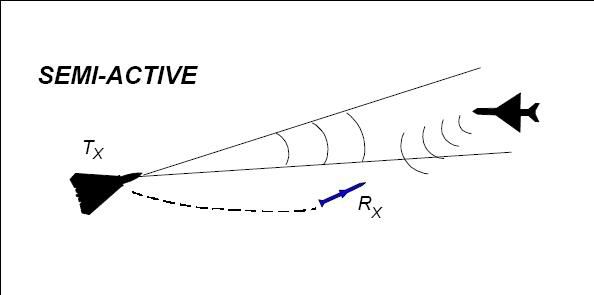But how does that translate into lesser capability and what difference does it make? None of Indian aircraft are Low Observable as far as I know. Given the ZDK-03's ability to provide surveillance and warning, I would not be complaining especially given the price and financing likely provided by Chinese friends.
Just a thought -
could Erieye's capabilities include ability to provide accurate targeting information to a BVR missile fired by a combat plane? That is the only difference that I could imagine arising out of the difference in scan resolution between Erieye and ZDK-03. This is just a guess and I would like more knowledgeable forum members to provide more information. I would really like @
gambit to comment on this, if he please.
There are two ways a missile could be 'guided': radar and data.
-
Radar. This is where another radar source, assume an AWACS for convenience, illuminate a target, then the missile uses any reflections as guidance beacon.
Like this...
It does not matter if the above illustration have the radar source as the parent missile launcher. The principle is still the same: the missile uses an external radar source.
-
Data. This is where another radar source, assume an AWACS for convenience, illuminate a target, analyzes that information, then transmit that information to the missile. This is not saying: 'Turn here or there.' That would be command guidance. This is saying: 'The target is at X altitude, moving at Y speed, and at Z heading.' That is target data. The missile then analyzes its own position in relation to the target and make appropriate maneuvers.
Which of the above is applicable to the Erieye ? I will leave that answer to the Pakistani members to research.
However, the simplest answer would be 'radar'. This method places the burden of target guidance entirely upon the missile. All the AWACS does is provide target illumination. If the AWACS is threatened by hostiles or struck by lightning and cannot sustain target illumination over a certain duration, then the missile is SOL (sh1t out of luck), as we Americans would say.
Data guidance have the advantage in that the source radar can 'burst' target information and this tactic is often used in heavy EM traffic situation, which could include countermeasures by the enemy. The companion issue here is how to preserve data integrity, which includes encryption so as not to provide false guidance to others. Greater sophistication would be for multiple friendly assets to use the same data guidance to attack a target from directions. The disadvantage is that both sender and receiver of data must have the same level of technical sophistication.
If the missile have its own radar package, that would be helpful for either of the above. The missile could use its own radar to illuminate the target and uses that information to correlate external guidance information. A fully 'active' missile, like the American AMRAAM for example, is the best way to go. With its own radar package, it could work with less sophisticated radar systems via 'raw' target illumination from any external source, or it could be 'silent' and be in 'beamrider' mode towards a target, or switches from active to passive to correlate as it flies.
Can an AWACS provide both radar and data guidance as situations demands? Absolutely.
Does the Erieye ? You guys will have to research for that.
Erieye - Wikipedia, the free encyclopedia
The Erieye AEW&C mission system radar is an active, phased-array, pulse-doppler sensor that can feed an onboard operator architecture or downlink data (via an associated datalink subsystem) to a ground-based air defence network.
The wiki source seems to imply so, but it is rather limited and quite narrow in focus: a ground based air defense network. But at least the ability to transmit formulated data is there, and not just providing raw target illumination.








